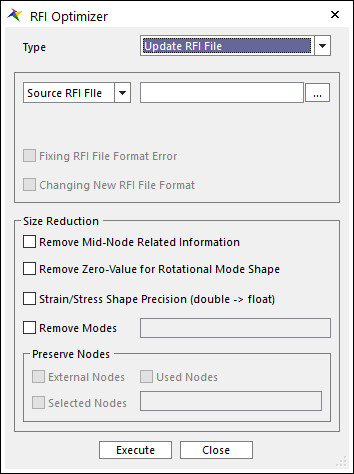10.3.2. Update RFI file
The default option the Update RFI file type is fixing the RFI file format error and changing the new RFI file format. And this type has three options to reduce the file size. After executing the Update RFI file type of RFI Optimizer, the new RFI file has the same to the original file name and the original file is renamed as “OriginalFileName.RFI.BAK” file.

Figure 10.88 RFI Optimizer dialog box [Update RFI file]
Type: Update RFI file type
Source RFI File/RFlex Body: Selects the RFI file.
Source RFI File: Selects the RFI file in somewhere directories.
Fixing RFI file format error: After selecting the RFI file, the GUI checks an error of the RFI file format. If the selected RFI file has the error, the checkbox is selected automatically.
Changing new RFI file format: After selecting the RFI file, the GUI checks the version of the RFI file. If the version of the RFI file is lower than the current version of the RFI file, the checkbox is selected automatically.
RFlex Body : Selects RFI file by selecting the RFlex body list of the combo box. If an RFI related some RFlex bodies, a line shows all the related RFlex bodies in the combo box.
Size Reduction
Remove Mid-Node Related Information
This option is applied in the parabolic element only and is not outputted in the RFI file when the information is related in the mid-node. The mid-node is the node among vertexes in the parabolic element.
The result of the position and velocity and acceleration for the marker defined on the mid-node in the markers of RFlexbody is changed by the use of this option
If the user uses this option, the user cannot use the following as functions.
Not supported functions
Static Correction Mode
RFlex Durability Interface for FEMFAT
Remove Zero-Value for Rotational Mode Shape
The rotational mode shape data is outputted in the RFI file as a sparse format.
The more zero value is large, the size reduction is effective. In general, the size reduction is effective when the solid element is used and it never influences the result of simulation.
Strain/Stress Shape Precision (double -> float): The stress/strain shape data is outputted in the RFI file as a single precision.
Remove Modes: Removes selected modes which is written in above text box. Mode ID must be distinguished by “,” and “-” character. “-” can be used for a series number. Don’t use blank as a distributor.
“1-6” is the same with “1,2,3,4,5,6”.
“1_6” is recognized as “16”. (“_” means a blank.)
This function does not remove all mode. If user set all mode of the input RFI, then the higher mode only remains in result RFI file.
Preserve Nodes: Removes the related information of the unselected nodes in the RFI file. This function allows a reduced RFI file. And this function is only available when the RFlex Body selecting option is used.
Following check box options set a node list called the first target remain nodes. The solver searches elements list related the first target remains. The second remain nodes are defined as all nodes in the elements list except the first target remains. Also, the node adjacent to the center marker of the RFlex body is defined as one of the remaining nodes for reference in the calculation. The unselected nodes are defined as all nodes excluding both the first and the second remains.
External Nodes: Selects a reference node and all external nodes.
Used Nodes: Selects a reference node and all used nodes. The used node indicates followings.
Marker reference nodes
Node Set
Patch Set
Element Set
Line Set
Output Node Set
Selected Nodes: User can select some Node Set in the target RFlex body using the “N” button. User can check the selected node sets.
Note
If the selected RFI file has the global stiffness matrix information and the user selects this option, the result of the RFI file is removed by the global stiffness matrix.
Note
When the Remove Modes and/or Preserve Nodes functions are used, then the RFlex body swapping is always used after making the new RFI file.